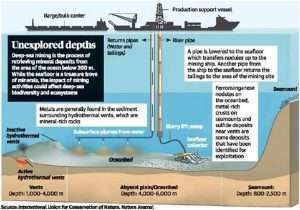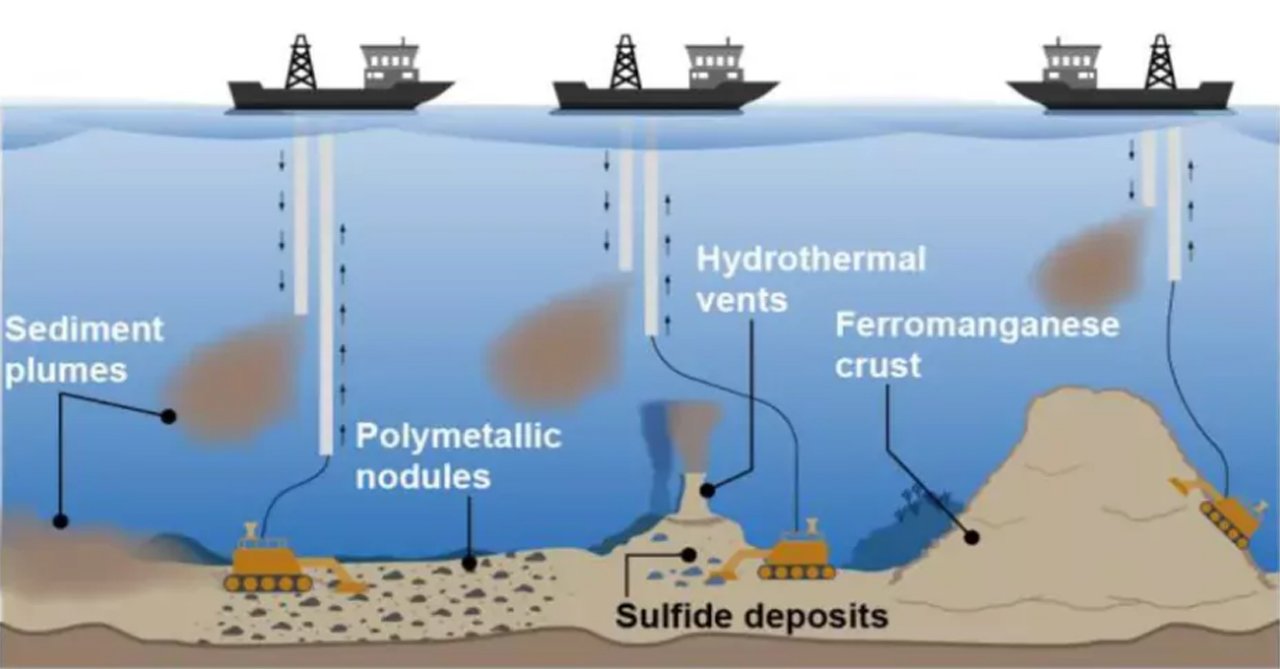India has still enough resources on the land but of late, it is being pulled to deep-sea mining? Explain the nature of deep sea mining in India and its likely impacts.
The story so far: India’s ambitious ‘Deep Ocean Mission’ is all set to be launched this year. Dr. MadhavanRajeevan, Secretary, Union Ministry of Earth Sciences, announced on July 27 that the ₹8,000-crore plan to explore deep ocean minerals will start from October. He said, “We finally have the in-principle approval to go ahead with the mission. Now expenditure plans will be drawn up and circulated [to various institutions affiliated to the Ministry] for executing programmes and we hope to launch by October 31.”
What will be the environmental impact?
According to the International Union for Conservation of Nature (IUCN), these deep remote locations can be home to unique species that have adapted themselves to conditions such as poor oxygen and sunlight, high pressure and extremely low temperatures. Such mining expeditions can make them go extinct even before they are known to science. The deep sea’s biodiversity and ecology remain poorly understood, making it difficult to assess the environmental impact and frame adequate guidelines.
Dr. Ramadass adds that though strict guidelines have been framed, they are only exploration guidelines. A new set of exploitation guidelines are being worked out and discussions are on with the ISA. Environmentalists are also worried about the sediment plumes that will be generated as the suspended particles can rise to the surface harming the filter feeders in the upper ocean layers. Additional concerns have been raised about the noise and light pollution from the mining vehicles and oil spills from the operating vessels.
Is deep sea mining economically viable?
The latest estimate from the ISA says it will be commercially viable only if about three million tonnes are mined per year. More studies are being carried out to understand how the technology can be scaled up and used efficiently.
India’s ambitious ‘Deep Ocean Mission’ is all set to be launched.
One of the main aims of the mission is to explore and extract polymetallic nodules. These are small potato-like rounded accretions composed of minerals such as manganese, nickel, cobalt, copper and iron hydroxide. They lie scattered on the Indian Ocean floor at depths of about 6,000 m and the size can vary from a few millimetres to centimetres. These metals can be extracted and used in electronic devices, smartphones, batteries and even for solar panels.
Deep Sea Minningis commercially viable only if about three million tonnes are mined per year.
The International Seabed Authority (ISA), an autonomous international organisation established under the 1982 United Nations Convention on the Law of the Sea, allots the ‘area’ for deep-sea mining. India was the first country to receive the status of a ‘Pioneer Investor ‘ in 1987 and was given an area of about 1.5 lakh sq km in the Central Indian Ocean Basin (CIOB) for nodule exploration. In 2002, India signed a contract with the ISA and after complete resource analysis of the seabed 50% was surrendered and the country retained an area of 75,000 sq km.
According to a release from the Ministry of Earth Sciences, the estimated polymetallic nodule resource potential in this area is 380 million tonnes (MT), containing 4.7 MT of nickel, 4.29 MT of copper, 0.55 MT of cobalt and 92.59 MT of manganese. Further studies have helped narrow the mining area to 18,000 sq km which will be the ‘First Generation Mine-site’.

India’s mining site is at about a depth of 5,500 metres, where there is a high pressure and extremely low temperature. India has developed and demonstrated the mining technology with artificial nodules at 500 metres depth. They have also deployed Remotely Operated Vehicle and In-situ Soil Tester in the depth of 6,000 metres and have a thorough understanding of the mining area at the Central Indian Ocean Basin.The mining machine newly developed for 6000 metres depth will be deployed soon at 5,500 metres. Weather conditions and availability of ships also play a role. More tests are being conducted to understand how to bring the nodules up to the surface. A riser system comprising an umbilical cable or electromechanical cable and a hose is being developed.”
What will be the environmental impact?
According to the International Union for Conservation of Nature (IUCN), these deep remote locations can be home to unique species that have adapted themselves to conditions such as poor oxygen and sunlight, high pressure and extremely low temperatures. Such mining expeditions can make them go extinct even before they are known to science. The deep sea’s biodiversity and ecology remain poorly understood, making it difficult to assess the environmental impact and frame adequate guidelines.
Environmentalists are also worried about the sediment plumes that will be generated as the suspended particles can rise to the surface harming the filter feeders in the upper ocean layers. Additional concerns have been raised about the noise and light pollution from the mining vehicles and oil spills from the operating vessels.
